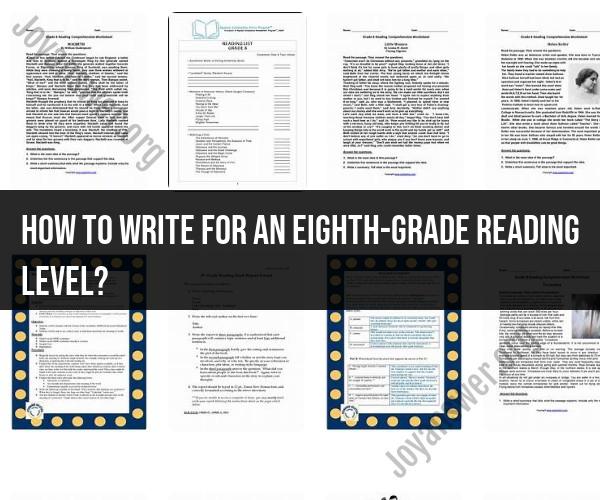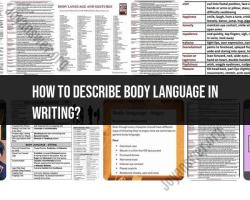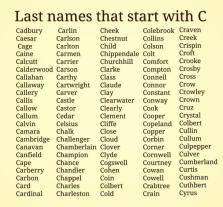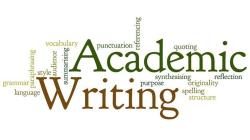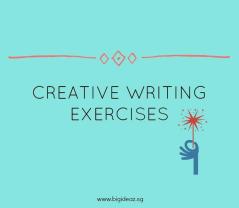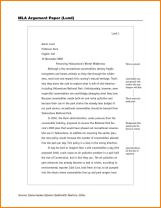How to write for an eighth-grade reading level?
Writing for an eighth-grade reading level requires clarity, simplicity, and consideration of your audience's comprehension skills. Here are some tips and guidelines to help you write effectively for an eighth-grade audience:
Use Clear and Concise Language:
- Choose straightforward and simple words over complex or technical vocabulary.
- Avoid jargon, slang, or unfamiliar terms unless you explain them in context.
Short and Varied Sentences:
- Keep sentences relatively short and avoid overly complex sentence structures.
- Use a mix of sentence lengths to maintain reader interest.
Organize Content Logically:
- Present information in a logical order, such as chronological, cause-and-effect, or order of importance.
- Use headings, subheadings, and bullet points to break up text and improve readability.
Define Key Terms:
- If you need to use technical or specialized terms, provide clear definitions within the text.
- Consider including a glossary if your content includes multiple technical terms.
Active Voice:
- Use the active voice (e.g., "The cat chased the mouse") rather than passive voice (e.g., "The mouse was chased by the cat") for clarity and directness.
Avoid Ambiguity:
- Be precise and avoid vague or ambiguous statements.
- Clarify any potentially confusing concepts or ideas.
Engage with Examples and Analogies:
- Use relatable examples and analogies to help explain complex concepts.
- Analogies can make abstract ideas more concrete and understandable.
Visual Aids and Graphics:
- Incorporate visuals, such as images, charts, and diagrams, to supplement the text and enhance comprehension.
Edit and Proofread:
- Carefully proofread your content for grammar, spelling, and punctuation errors.
- Ensure that your writing is free from typos or confusing language.
Test Your Writing:
- Share your content with individuals at or near the eighth-grade reading level to gather feedback and make improvements.
Consider the Reading Level:
- Utilize readability tools and software that can assess the reading level of your text, such as the Flesch-Kincaid Grade Level or the Gunning Fog Index.
Empathize with Your Audience:
- Put yourself in the shoes of an eighth-grader and consider their background knowledge and interests.
- Write with empathy and respect for your readers.
Iterate and Revise:
- Be open to revising and refining your content based on feedback and testing.
- Continuously strive to make your writing more accessible and engaging.
Remember that writing for an eighth-grade reading level does not mean "dumbing down" your content but rather making it more accessible and comprehensible to a broader audience. It's about effective communication and ensuring that your message is clear and easily understood by your intended readers.
Writing for Eighth-Grade Reading Levels: Tips for Clarity and Accessibility
Writing for an eighth-grade reading level means using language that is clear, concise, and easy to understand. It also means avoiding complex sentence structures and jargon.
Here are some tips for writing for eighth-grade reading levels:
- Use simple words and phrases. Avoid using long or complex words that your audience may not understand. If you must use a complex word, be sure to define it clearly.
- Use short sentences. Break up long sentences into shorter, more manageable ones. This will make your writing easier to read and understand.
- Use active voice. Active voice is more direct and easier to understand than passive voice.
- Be specific. Avoid using vague language. Instead, be specific and provide concrete examples.
- Organize your writing clearly. Use headings, subheadings, and bullet points to organize your writing and make it easier to scan.
Communicating Effectively: Guidelines for Writing at an Eighth-Grade Level
Here are some additional guidelines for writing at an eighth-grade level:
- Use a variety of sentence structures. Avoid using the same sentence structure over and over again. This will make your writing more interesting and engaging.
- Use transition words and phrases. Transition words and phrases help your audience follow your train of thought. Some common transition words and phrases include "however," "therefore," "in addition," and "finally."
- Proofread your work carefully. Before you share your writing with others, be sure to proofread it carefully for any errors in grammar, spelling, or punctuation.
Crafting Clear and Understandable Content for a Broad Audience
When crafting clear and understandable content for a broad audience, it is important to keep the following tips in mind:
- Consider your audience. Who are you writing for? What is their level of knowledge and understanding of the topic? Tailor your writing to your audience's needs.
- Use plain language. Avoid using jargon or technical terms that your audience may not understand. If you must use technical terms, be sure to define them clearly.
- Be concise. Get to the point quickly and avoid using unnecessary words.
- Be organized. Use a logical structure to organize your writing and make it easy to follow.
- Use visuals. Visuals, such as charts, graphs, and images, can help to make your writing more engaging and easier to understand.
By following these tips, you can write clear, concise, and accessible content that will be easy for a broad audience to understand.
